An American Hero: 40 years after gold, Jenner comfortable in her own skin

This story appears in the July 4–11 edition of Sports Illustrated. Subscribe to the magazine here.
“C’mere.”
From a tall, upholstered stool in the kitchen of her hilltop Malibu home, Caitlyn Jenner stands and smacks my shoulder with her right hand while swiveling her chin toward a hallway. Her shoulder-length brown hair flips hurriedly across her face, as if in pursuit. She takes a few long strides, turns left and walks through her bedroom-sized closet, into the bathroom and to a vanity, with two stacks of lightbulbs flanking a mirror. She bends to open the middle of three drawers, where a white plastic, zippered cosmetics case decorated with a pattern of a woman’s lips sits on top. She snatches the case and tosses it onto the vanity and retrieves the item below, a wooden box stained dark red, wrapped in a brown leather sleeve and embossed with the logo of the 1976 Summer Olympic Games.
“Here it is,” says Jenner. “In my nail drawer. That’s what you can say: It was in the nail drawer.”
Jenner has been performing in public for much of her adult life; she understands the impact of spoken words, the way they make some people smile and others seethe, the way they peel back layers, eliciting affirmation or exposing intolerance. Most of her words do this, especially now, as do most of her actions, including drawing breath.
The 66-year-old Jenner slides off the sleeve and flips open the lid, revealing the gold medal she earned 40 years ago for winning the Olympic decathlon, with a score that would be competitive for a place on the 2016 U.S. team to be selected this week. (Think about that.) The medal is imperfectly round, with rough, sculpted edges, nestled in felt and attached to a metal chain. It’s the same chain that was draped around Jenner’s neck on the night of July 30, 1976, at the Olympic Stadium in Montreal, the same medal that Jenner lightly kissed before turning and seeing the American flag raised and hearing “The Star-Spangled Banner.” Now as quickly as she had retrieved and displayed the medal, she snaps the box shut, wraps the sleeve around it, drops it back in the nail drawer and sets the plastic case on top.
Jenner has a complex relationship with the medal in the bathroom, in the drawer, in the box beneath the plastic case. It commemorates extraordinary work that allowed her to withstand the pain of what is now called gender dysphoria but then was seldom talked about at all.
“The decathlon,” she says, “was the perfect distraction.”
A decathlon victory is a rare achievement—there are only 22 Olympic gold medalists (12 American)—but to Jenner it can at times feel insignificant. It represents one of the greatest moments of her life, yet her life is different now. “Sports. It’s not real life,” she says. “You go out there, you work hard, you train your ass off, win the Games. I’m very proud of that part of my life. And it’s not like I just want to throw it out. It’s part of who I am. What I’m dealing with now, this is about who you are as a human being. What did I do for the world in 1976, besides maybe getting a few people to exercise a little bit? I didn’t make a difference in the world.”
The medal has been sometimes in a drawer and sometimes in a safe, but never on display. Years passed when she didn’t even look at it. “The medal,” says Jenner. And then she shrugs. “It was great for the kids at show-and-tell.”
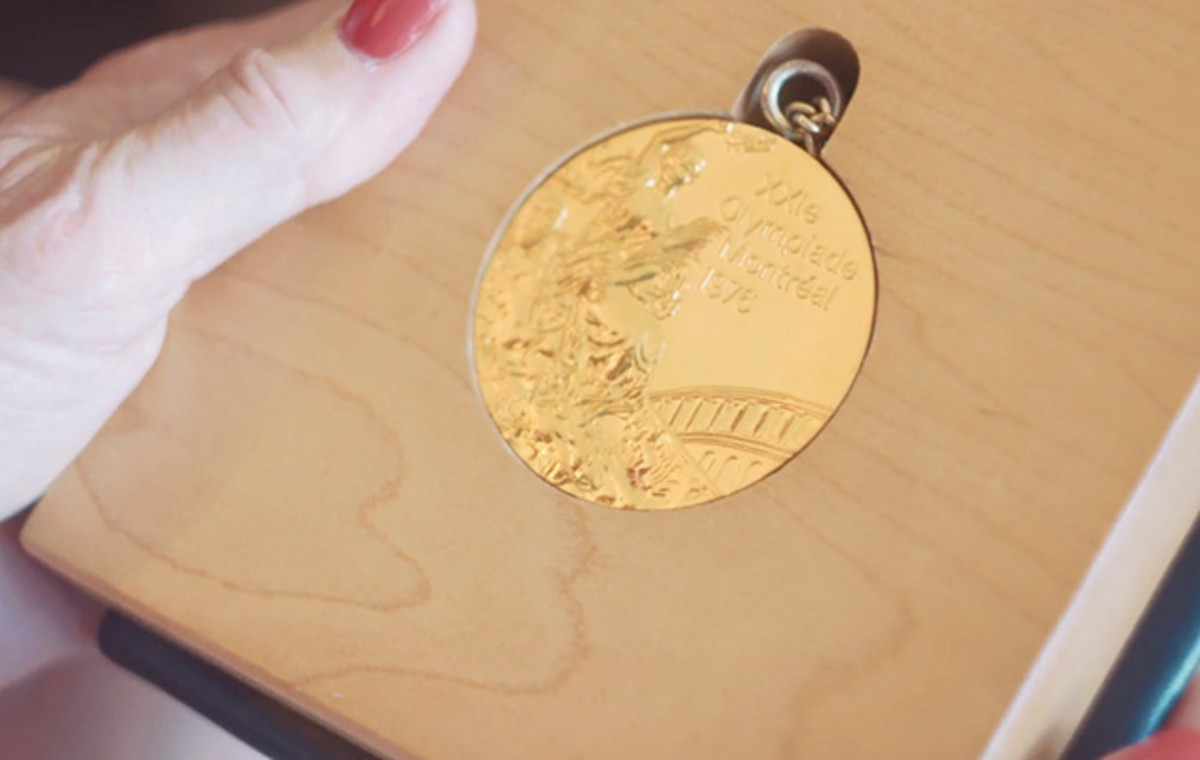
It’s true: the Olympic Games are play, and life is real. A medal rewards great achievement, but ultimately it’s just a paperweight. But. But. But: What if there is no medal? If there is no medal, a 26-year-old athlete named Bruce Jenner, who presents and competes as male (but even then, and long before, feels strongly that he is female), does not leave Montreal famous, does not get stopped on the streets of New York City for autographs, does not become a (useful) broadcaster and (painfully bad but well-paid) actor, does not become comfortably wealthy (and eventually not, and then wealthy again). If there is no medal, Jenner probably does not, after two divorces, marry Kris Kardashian in 1991 and become a player in one of the most popular reality television series in history. If there is no medal, Jenner does not, at 65, attract an audience of more than 17 million for a prime-time special in April 2015 when she announces to ABC’s Diane Sawyer that she will soon complete the transition to living as a woman; and does not, two months later, pose languorously on the cover of Vanity Fair in a corseted silk bodysuit and on the day of its release accumulate more than one million Twitter followers in four hours—faster than President Obama, the previous record holder. If there is no medal, she does not launch her own reality series on E! network last July, I Am Cait, which details her life in transition.
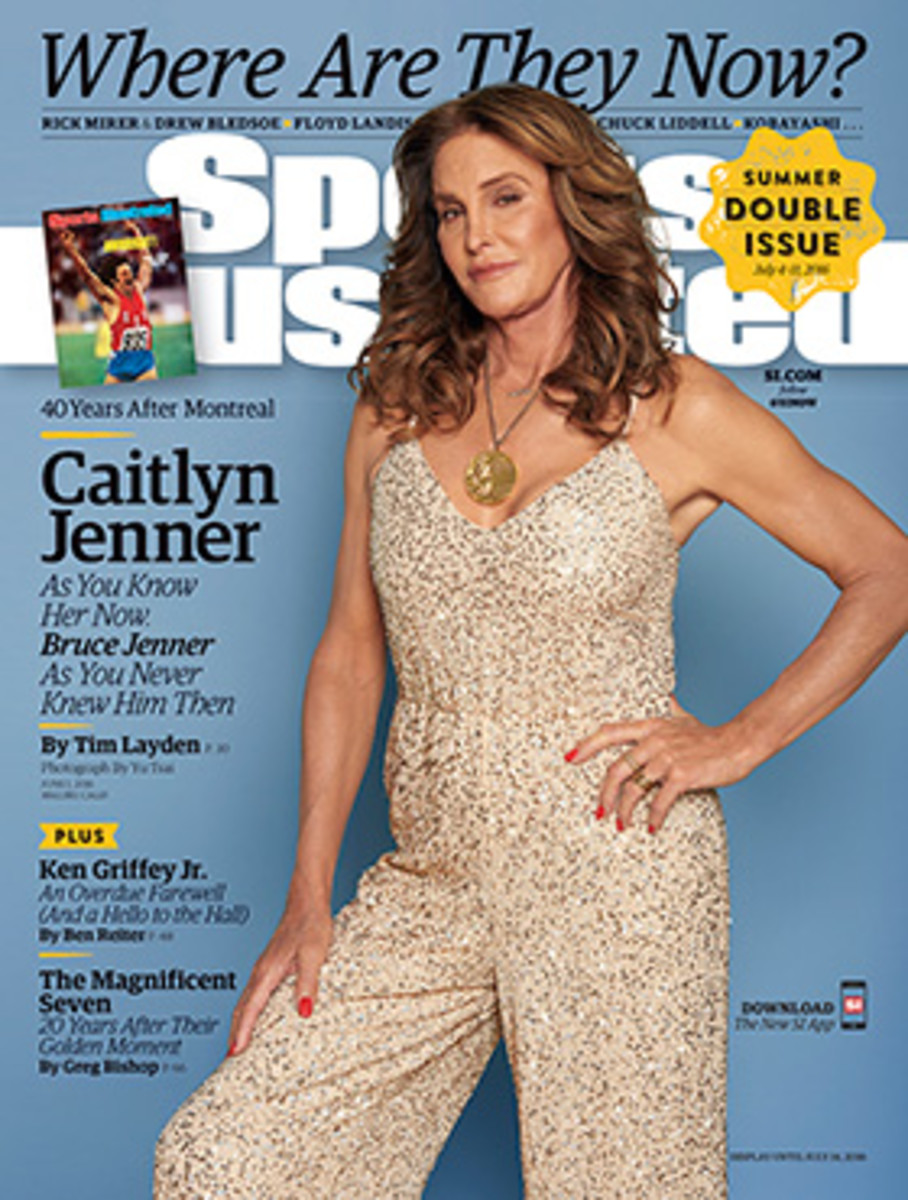
If there is no medal, Caitlyn Jenner almost certainly does not become the most famous transgender person in history. She does not become a towering (literally, 6' 4" in heels) public figure who both unifies and polarizes (even within the trans community) while spurring discussion of gender issues in ways that no one else has. She has used her celebrity—earnestly, sometimes naively, on a steep learning curve, with millions watching—to help the 700,000 trans men, women and children in America who battle not only intolerance but also suicidal thoughts, depression and poverty at staggering rates and who are just gaining a foothold in society. “I feel like, now, nobody can say they don’t know a transgender person, because she is that famous,” says Chris Mosier, 35, a transgender male triathlete who represented the U.S. at the world sprint duathlon (cycling and running) championships last month in Spain. “She has brought about this awareness among people who are attuned to pop culture and media. Challenges that trans people face have really come to light since she’s come out.”
If there is no medal, she does not affect the lives of thousands of families trying to find their way in a trans world that many scarcely knew existed. Says Dr. Johanna Olson-Kennedy, adolescent medicine specialist in the care of gender nonconforming children and transgender youth at Children’s Hospital Los Angeles, “For parents who are scared or nervous about having a child come out as transgender, it suddenly feels like they’re not the only one, because they remember Caitlyn from the Olympics, and this is real. And for the kids, if they know Caitlyn at all, it’s from the Kardashians, but for them, their life is impacted by their parents’ being more open to their journey. It’s a lot easier for them if they have affirming and supportive parents.”
If there is no medal, an April video of Jenner using the women’s bathroom at Trump Tower in New York City and afterward saying, “By the way, Ted [Cruz], nobody got molested,” does not get viewed 2.5 million times in five days. The video was a response to a North Carolina law that requires people to use the public bathroom that corresponds to the gender assigned to them at birth, regardless of how they identify. “It’s a ridiculous law,” she says.
If there is no medal, Jenner does not pose on the cover of this magazine, a few weeks shy of 40 years since her last Sports Illustrated cover, in which Bruce Jenner was captured crossing the finish line in Montreal, letting loose a triumphant scream. She does not put the medal around her neck, in public, for the first time since the Olympic Games. It is a startling pose that delivers two messages. The first lands softly, celebrating an aging sports hero on the anniversary of a proud moment. The second hits more forcefully, a transgender American, thanking her country for its tolerance, and asking for more. Jenner understands the power of the image. “It’s a picture that brings attention to this issue,” she says. “That’s the important thing. That’s why I wore the medal.”
If there is no medal, there is none of this. “If I had not won the Games, if I was not on the Wheaties box and I hadn’t become this, um, this . . . celebrity, would all of this have happened?” asks Jenner. She pauses. Jenner gave speeches for four decades as Bruce, and now for a year as Caitlyn. When off script, though, she speaks less decisively. “Certainly life would have been different. The gender issues, I was never getting away from. But things would have been different. I would hope I would be doing some of the things I’m doing today, but certainly not on the same scale.”
• From the Vault (1976): SI’s cover story from Jenner’s decathlon gold medal
But Jenner did win the medal, and it now becomes one of the most significant gold medals that any American has won, a trinket that could effect change and save lives. On July 29 and 30 of the Bicentennial summer, in a city just 40 miles north of the U.S. border, Jenner scored personal bests in seven of the decathlon’s 10 events, broke his own world record with a mark that would have won a medal in seven of nine subsequent Olympics and taken gold in three, and prevailed by a margin that has been exceeded just once. Jenner was transformed into the type of American sports hero who no longer exists, a homespun, gosh-darn conqueror of evil Soviets (precursor to the hard-nosed, apple-cheeked hockey players who would arrive four years later in Lake Placid). He hugged the beautiful wife who had helped support him, waved a little American flag on a stick that was thrust upon him by a spectator and refused to lie on the ground in decathlete’s exhaustion.
ABC put together a minidocumentary that aired a day later. It opens with Jenner running off the final curve of the 400 meters, the last event on the first day of the decathlon, to the familiar and comforting voice of broadcaster Jim McKay. Nearly seven minutes later it ends with Jenner walking down the backstretch in his red USA singlet and shiny blue shorts, pumping both fists at the sky while McKay intones:
“This is an American moment, this time for a Bicentennial summer. Jenner looks ready for another event. . . .”
The 1976 Olympics were produced by ABC impresario Roone Arledge, the godfather of “up close and personal” coverage. “Roone knew stardom when he saw it,” says veteran broadcaster Al Michaels, who joined ABC Sports in 1976 but was not in Montreal. “Olga Korbut, Mark Spitz, Nadia Comaneci. And Bruce Jenner. And Roone milked the hell out of stardom.” Jenner was Captain America.
• From the Vault (1977): Jenner is Montreal Games’ most marketable hero
Jill Soloway, 50, creator and executive producer of the Emmy Award–winning Amazon series Transparent, whose central character is a transgender woman in her late 60s (who, like both Soloway’s father and Jenner, transitioned late in life), watched the Montreal Olympics, at age 10, at her family’s home in Chicago. “The most significant thing to me about 1976,” says Soloway, who has become friends with Jenner, “is that she was an American hero. And it wasn’t just about an Olympic medal, it was about an Olympic medal in the most American of years. You think about the gold medal and flag and running shorts, and you have that image in your heart. To not support Caitlyn now is, in some ways, a destruction of a part of you that believes in a certain ideal of American heroism.”
On that Friday, Jenner stepped into an exalted place in U.S. sports history. Yet, for her, it was very much about the consuming passion that was about to be left behind, and the uncertainty that lay ahead. “For those two days in July of 1976, I was the best in the world at what I did,” says Jenner. “On the other hand, the decathlon was my best friend, and that was over. I lost my beard.”
A word here about pronouns and first names, about which the transgender community is understandably sensitive. Last spring, in the wake of Jenner’s announcing her transition, GLAAD (formerly an acronym for the Gay and Lesbian Alliance against Defamation but now simply the organization’s title, representative of a broader mission that includes transgender people) issued a series of guidelines, including one that Jenner be referred to as Caitlyn or she or her, even in reference to the events of 1976. Most transgender people choose to leave their pretransition life—and name—far behind. Jenner, however, often talks about Bruce. “Caitlyn doesn’t mind,” says Nick Adams, director of programs, transgender media for GLAAD, and a transgender male. “She has this world of fame in her past. The fact that it doesn’t grate on her like it does most trans people is unique.” With Jenner’s approval, in this story, the historical figure who won the gold medal in 1976 is referred to as Bruce and with male pronouns. The woman who lives now as Caitlyn is referenced with female pronouns.
1976
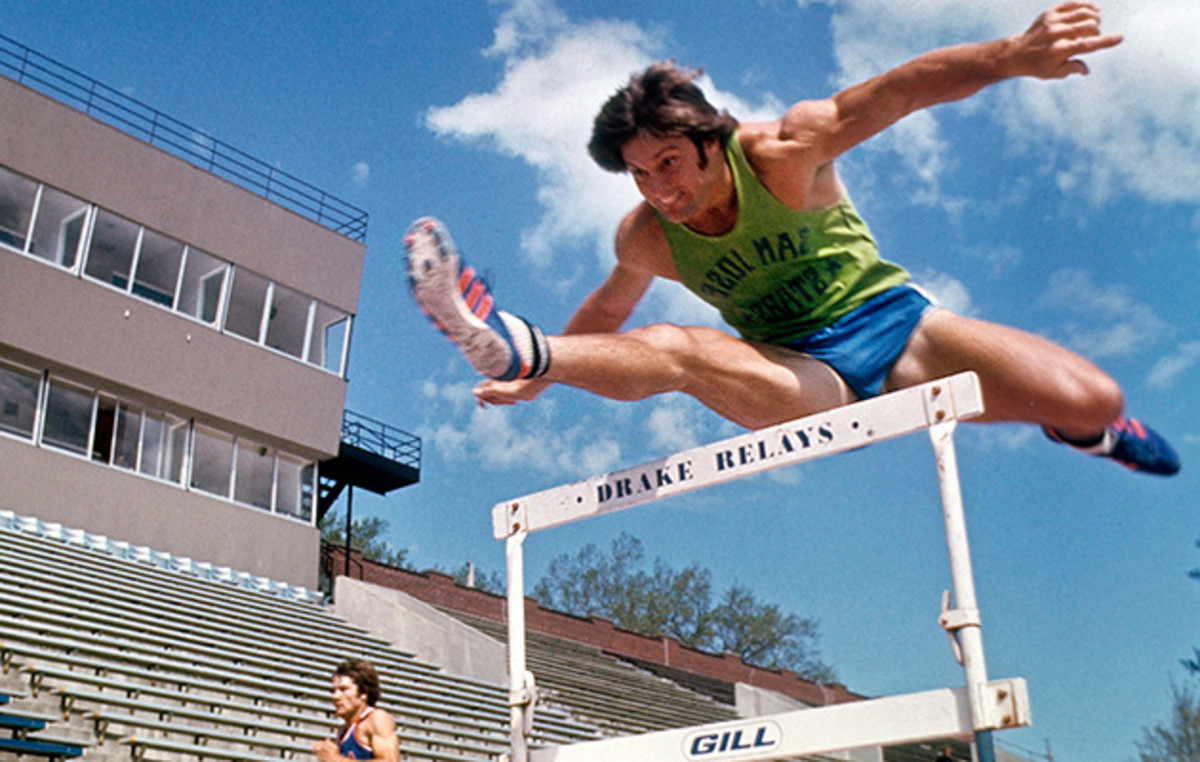
Jenner’s path to Montreal began as a freshman at Sleepy Hollow (N.Y.) High, in a suburb on the Hudson River 30 miles north of New York City. He excelled at football and basketball before gravitating to the pole vault. It is an event that demands the courage to throw yourself upside down into the air while bending a long fragile stick; it’s the most dangerous and harrowing of events, with a high risk of serious injury. But Jenner had worked for his father, a tree surgeon; he was fearless, and quickly successful. The family moved to Newtown, Conn.—46 years later the site of the Sandy Hook school shootings—when Bruce was a junior, and he won the state title that year with a vault of 12' 6" and again as a senior, in 1968, clearing 12' 9", more than respectable for the time. He won the state high jump title too in ’68 and dabbled in the long jump and javelin.
At 19, the 6' 2", 180-pound Jenner might have been a useful Division II or III football or basketball player, but he was dyslexic, with poor grades and little confidence in the classroom. There were no scholarship offers until the summer after graduation. A rival high school coach from Connecticut reached out to L.D. Weldon, the crusty track and field coach at tiny Graceland College in southern Iowa. Weldon, who was 60 at the time, had coached 20-year-old Jack Parker to a bronze medal in the decathlon at the 1936 Olympics. Weldon died in 1989, but five years earlier he told The Los Angeles Times that he heard “about this boy who could high-jump 6' 2", throw the javelin 185 feet and pole-vault 13' 6". I figured he had possibilities.”
It took a full year in Lamoni, Iowa, including a knee injury playing football and a season on the basketball team, before Jenner came fully to Weldon. But once Jenner tried the decathlon, progression was extraordinarily swift; in his first full competition (the first decathlon he had seen)—the 1970 Drake Relays—he finished sixth, in a field of Olympic hopefuls, with a school-record 6,991 points. A year later he was second with 7,402 points. And a year after that the 22-year-old Jenner stunned the track and field community by earning a place on the 1972 Olympic team with a third-place finish at the trials in Eugene, Ore. He was 11th after the first day and fifth with only the 1,500 meters remaining. He flipped through the pages of the decathlete’s scoring book and calculated that he needed to beat Steve Gough, who was then in third place, by 18 seconds. “My heart was beating so hard I started getting pins and needles in my hands and feet,” says Jenner. “I decided, I’m going to make this team if I gotta f‑‑‑‑‑‑ crawl across the line.” Jenner, wearing a scruffy Fu Manchu, ran a personal best by eight seconds and beat Gough by 22.
“That was the greatest athletic moment of my life, even better than the Games in ’76,” says Jenner now. “I never thought I could do something like that. But when the time came to dig down really deep, there was something there. And it never left me after that race.” There were other benefits too. Decathlete Harry Marra, who had not qualified for the trials but attended as a spectator, recalls seeing Jenner standing on a second-floor dormitory catwalk a few hours after the race surrounded by free shoes and athletic clothing. “Harry!” said Jenner. “Look at this free stuff.”
It was during those two days that Jenner’s decathlon persona was born. The competition is spread over two days, five events on each one. There are three flat running events (100, 400 and 1,500 meters), three throws (shot put, discus and javelin), three jumps (long jump, high jump and pole vault) and the 110-meter hurdles. Jenner was an exceptional athlete (he had been a waterskiing champion as a teenager too) who would pack a muscular 200 pounds on that 6' 2" frame. But he was not naturally fast or explosive in the way that many other U.S. decathlon gold medalists have been. Ashton Eaton (2012), Dan O’Brien (1996), Bill Toomey (1968) and Milt Campbell (1956) are, or were, exceptional at some combination of sprinting, hurdling and long jumping. “Bruce was actually a slowish guy for a world-class decathlete,” says Frank Zarnowski, 73, a decathlon expert, announcer and guru for more than four decades and a friend of Jenner’s since 1971. “He had to squeeze every point out of every event.”
It is the long way to decathlon gold. Jenner would have to beat the event into submission with training and consistency, which fed Jenner’s inclination toward obsessiveness. “My greatest asset was my brain,” Jenner says. “I will outwork you, and I will perform under pressure.” In this way the decathlon was perfect. With so many events, the training is endless. “Twenty-four seven, 365,” says Fred Samara, 66, who was Jenner’s training partner in the two years before Montreal. “I was just looking at my workout book from 1975. There is a training entry in there for Thanksgiving Day. There’s an entry for Christmas Day. And there’s an entry for January 1. And Bruce was with me for every one of those.” The routine was perfect for Jenner. More on that later.
In 1973, a year or so after graduation from Graceland, Jenner moved to San Jose with his wife, Chrystie, a minister’s daughter who had also attended the university. They drove west in their 1963 Volkswagen Beetle. Jenner went to San Jose because the city had become a thriving—though unofficial—training center for two dozen athletes with Olympic aspirations. Many of them were throwers, like discus men Mac Wilkins (who would win gold in Montreal) and John Powell (bronze) and shot‑putter Al Feuerbach (fourth). Samara and his wife lived three doors down the hall from the Jenners and their new dog, a yellow Lab named Bertha. Chrystie got a job as a flight attendant with United Airlines, which would be the couple’s primary source of income; Bruce earned $700 a month selling life insurance, a job on which he spent little time. These were the days when professional athletes were still barred from the Games.
Jenner did not have a coach. He was confident that he could train himself in sprints and distance. He kept a hurdle in the living room, a detail that made its way into nearly every story written about him during the run‑up to Montreal. As for the other events, “if I needed help with my discus, I would go to Mac Wilkins,” says Jenner. “If I needed help in the shot, I would ask Al Feuerbach.”
The athletes who trained with Jenner before the ’76 Olympics remember an earnest, agreeable workaholic. Of course they were all workaholics. “Bruce was just one of the guys,” says Wilkins, 65, who still coaches U.S. throwers. “He would come around the throwing ring, and I would tease him, ‘Hey, here comes the world’s best average athlete.’ As a thrower, his skill level was pretty good. It just doesn’t go very far because he weighs, like, 200 pounds. But he had nine other events, and we understood that.” (Jenner threw the discus farther in Montreal than any other decathlete—and farther than any decathlete in 2012—and finished second in the shot put.)
The San Jose crew would gather several times every week for weight training at the Central YMCA. These were intense sessions; throwers are often powerful lifters. In fact, Feuerbach won his division in the U.S. powerlifting championships. “I can picture Bruce perfectly in those sessions,” says Feuerbach, 68, who had a long career as a sound engineer with 60 Minutes and NFL Films. “I might be on the platform with 400 pounds on the bar, and Bruce would get right up there, and we’d help him knock it back to 285, which is still impressive. It was ballsy for him to get up there. Bruce was a positive, easygoing guy. But he had that confidence.”
(In 1988, Jenner said, in an interview with CNN, that he had experimented with banned substances for a brief period during his career but quickly stopped. Today, Caitlyn says, “I don’t remember saying that, but I never did anything. I never had a problem getting bigger naturally. And I was scared to death that I would get caught.” Feuerbach also says he never used PEDs and never saw them used by others.)
By the summer of 1975, Jenner was the best decathlete in the world. After no‑heighting in the pole vault (which results in zero points and certain defeat) at the national championships, he broke ’72 Olympic gold medalist Nikolay Avilov’s world record in August in Eugene and won the Pan Am Games in Mexico City in October. He was metronomically efficient in the field events, and his speed was improving. And there was always the 1,500—many decathletes coast though the race, but Jenner, all thick-legged and barrel-chested, hammered it, every time. “He was a great distance runner for his size,” says Zarnowski. “If it was even close after nine events, he knew he would kick everybody’s ass in the 1,500, and they knew it too.” Kenny Moore, an Olympic marathoner in 1968 and ’72 and for many years afterward a writer for SI, recalls running 300-meter intervals with Jenner on the Stanford golf course, a pencil-thin distance runner and rugged decathlete, matching strides in 45-second repeats.
Jenner took pride in never collapsing to the track at the finish of the 1,500, as many decathletes do, often theatrically. After breaking his world record at the world championships last summer in Beijing, Eaton crumpled at the finish of the final event. Jenner called him, first to congratulate him, then to chide him: “Americans,” Jenner said, “don’t fall down in the decathlon.”
There was a sense among his peers that Jenner was on the verge of that rare quality: bankable Olympic stardom. With the assistance of San Jose Community College coach Bert Bonanno, he had formed his own “track club,” called the San Jose Stars, of which he was the only member. This allowed Jenner to accept a whopping $6,000 from Adidas, by having the money funneled through Bonnano and the “club” without compromising his amateur status. “There would have only been a few people getting more than that, if any,” says Dwight Stones, an Olympian in 1972, ’76 and ’84 and another of Jenner’s friends. “You weren’t supposed to be making a damn thing.” In the spring of the Olympic year Jenner took a call from Hollywood agent George Wallach but says she did not sign a deal, which would have made Jenner ineligible for the Games. They kept in touch.
Bruce Jenner at the 1976 Summer Olympics
Bruce Jenner at the 1976 Summer Olympics
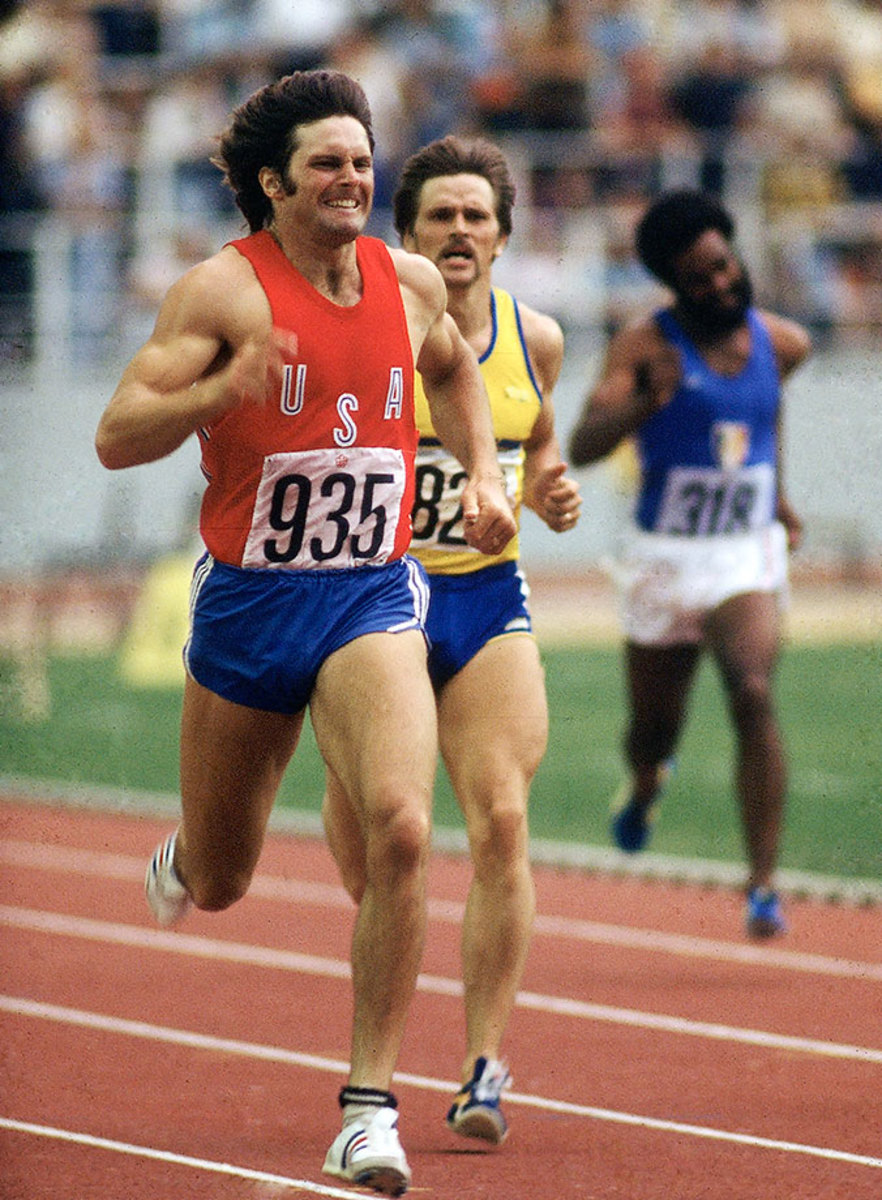
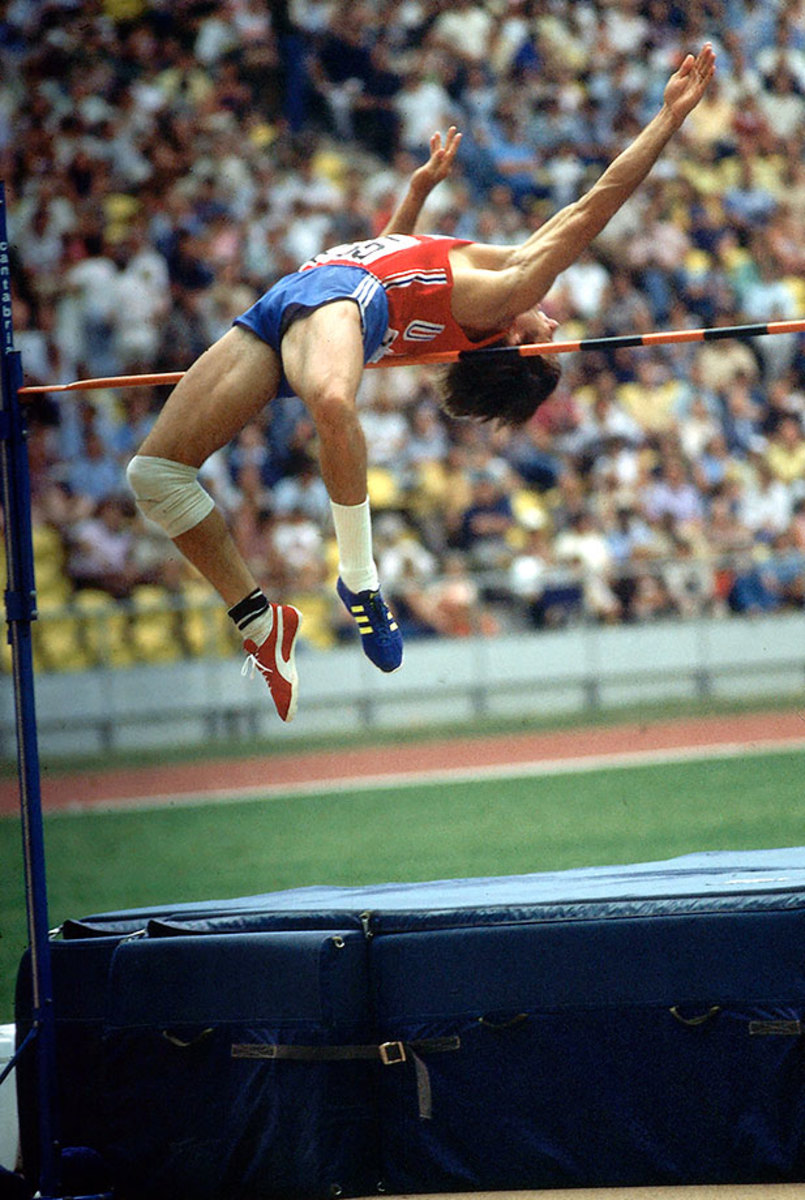
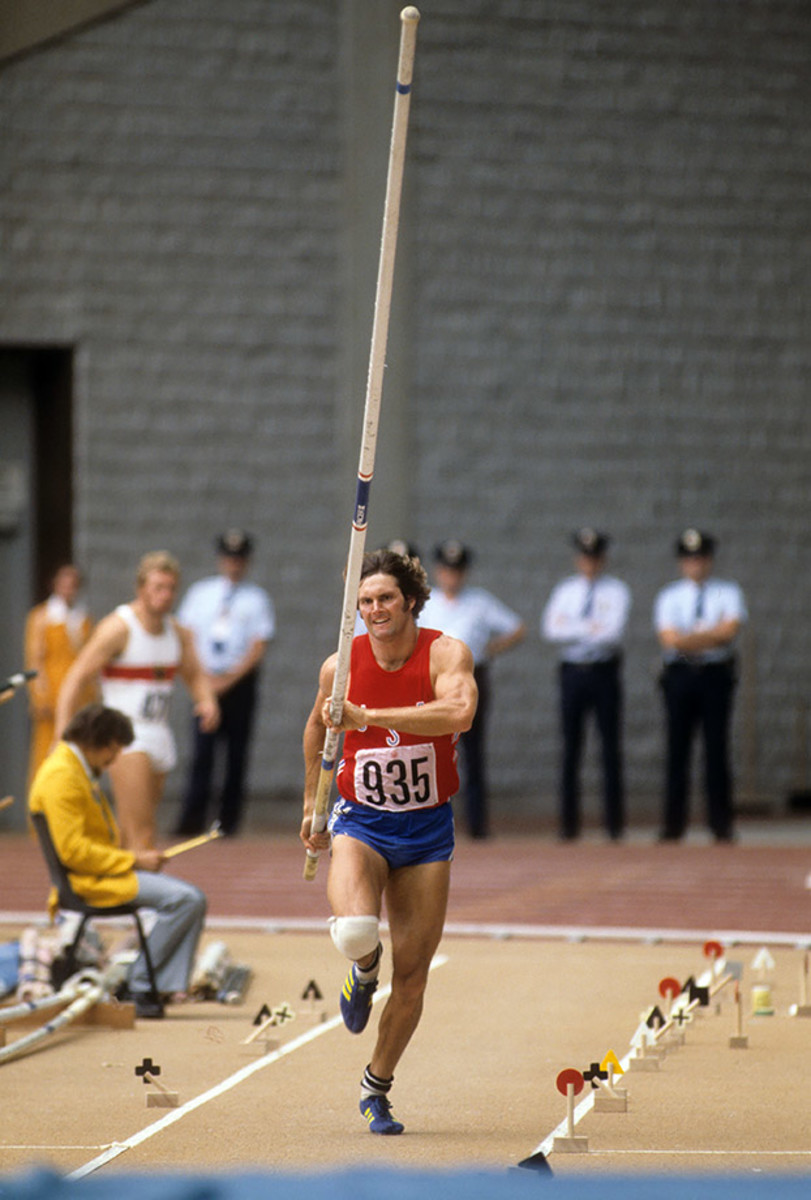
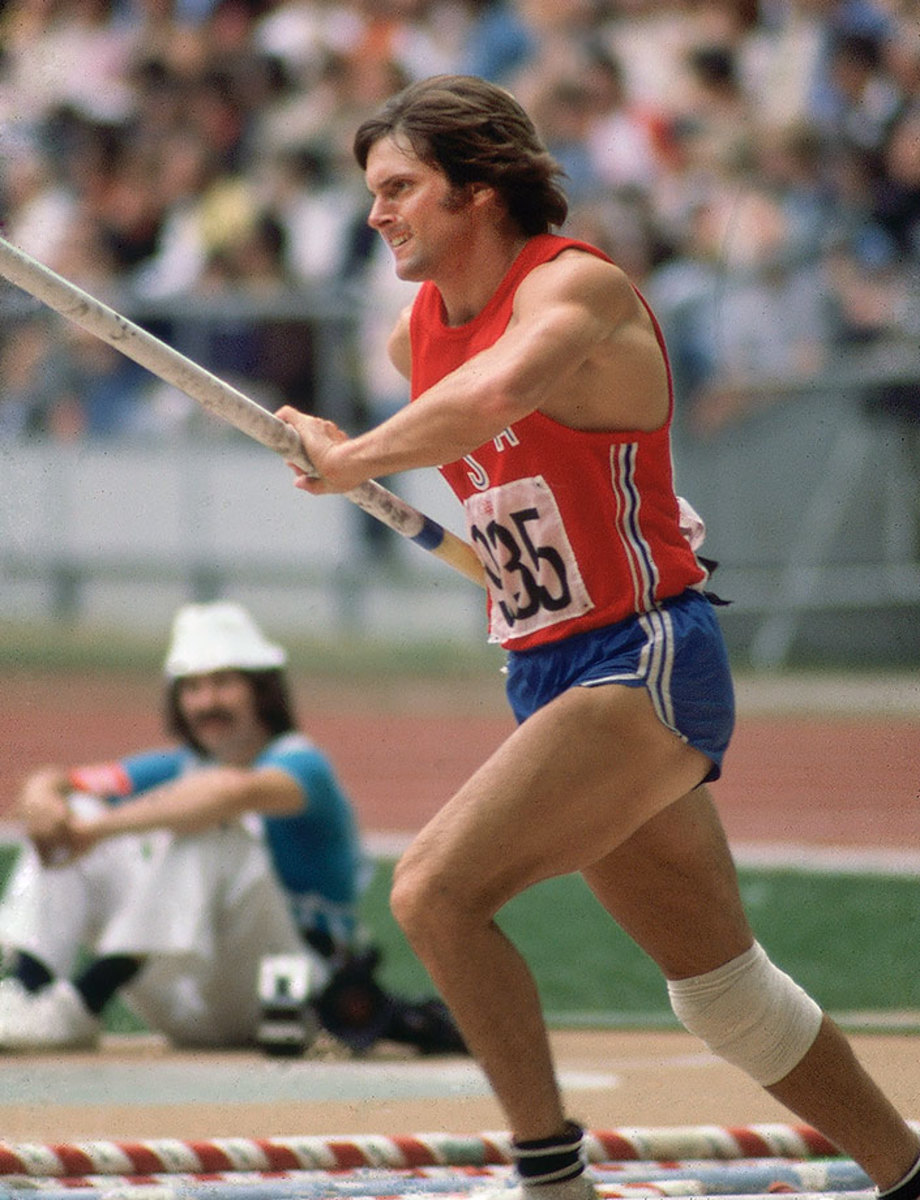
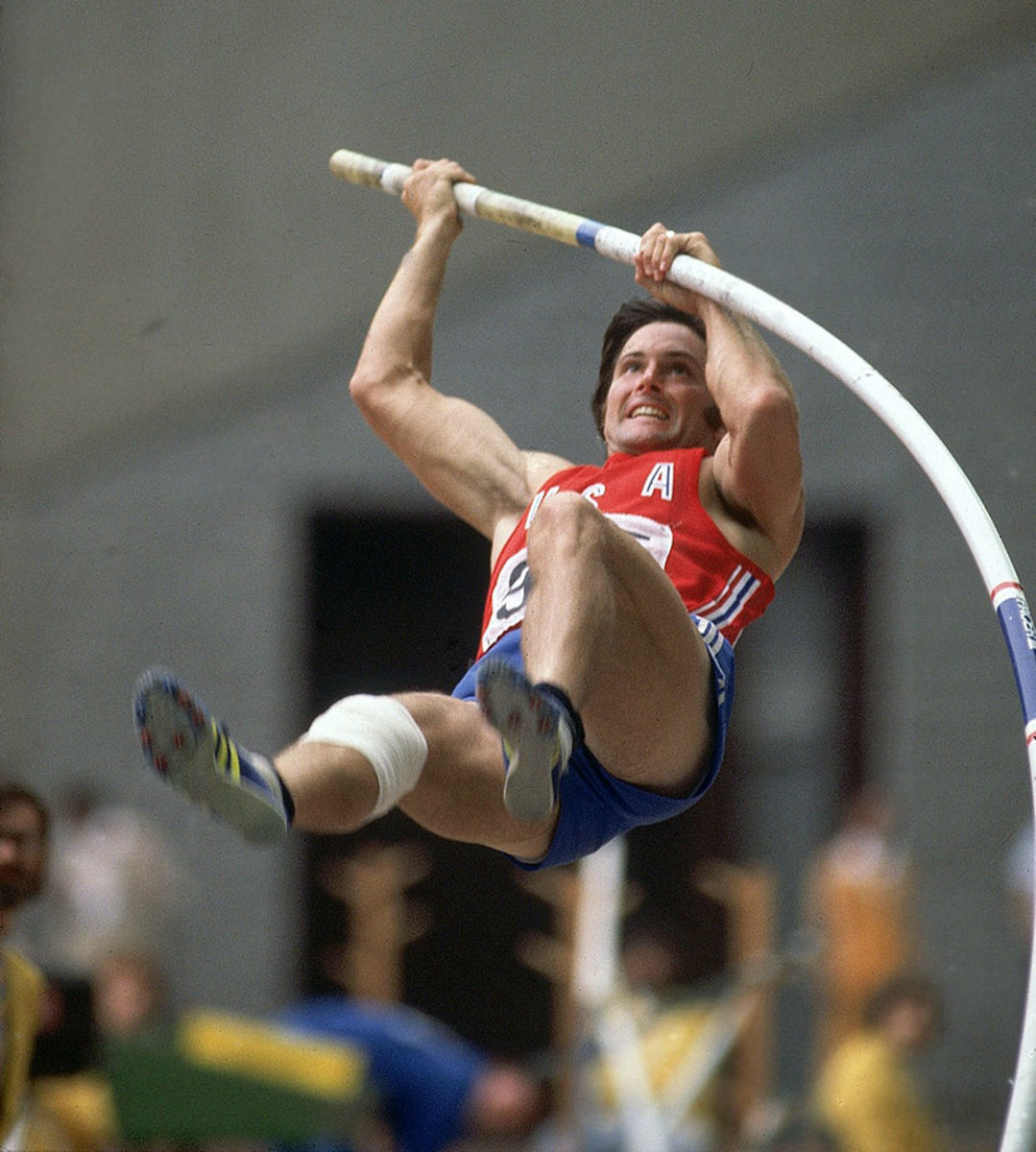
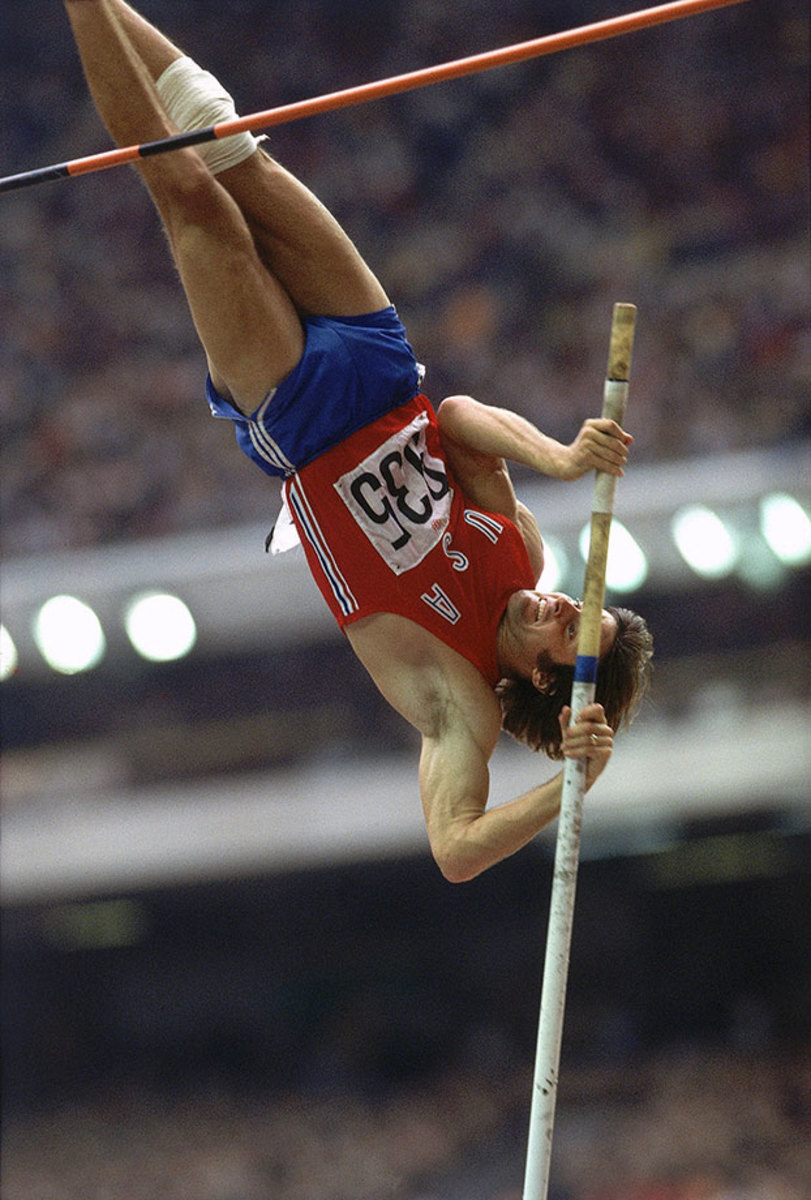
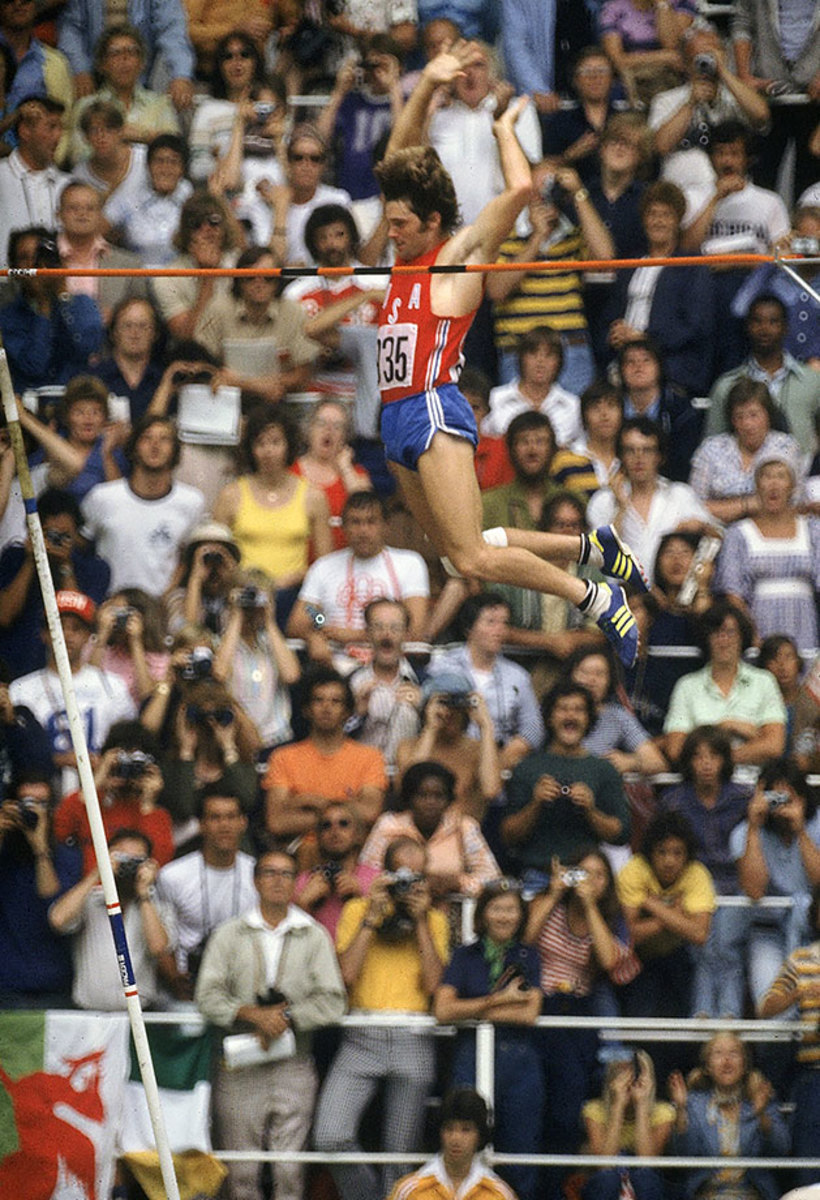
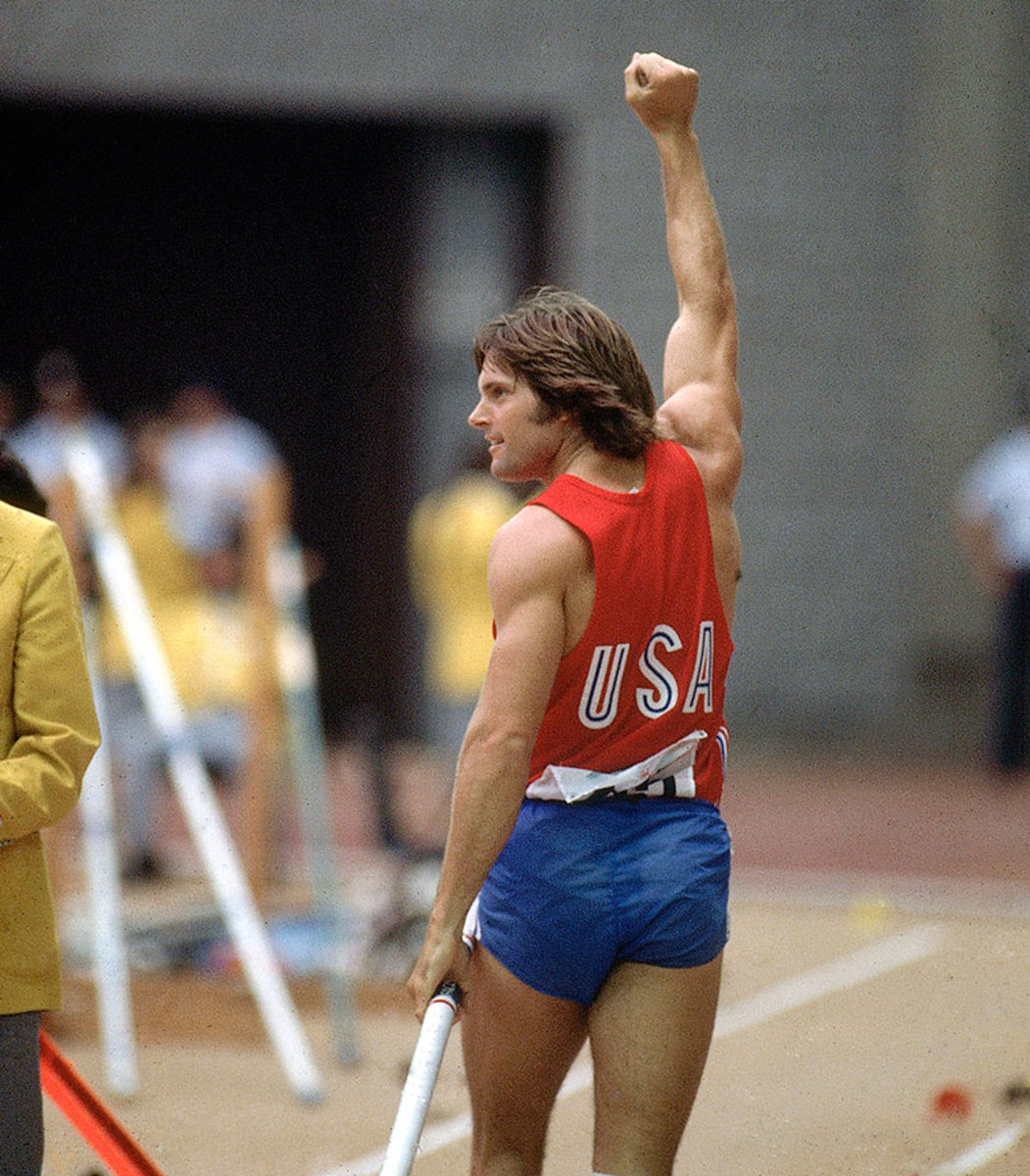
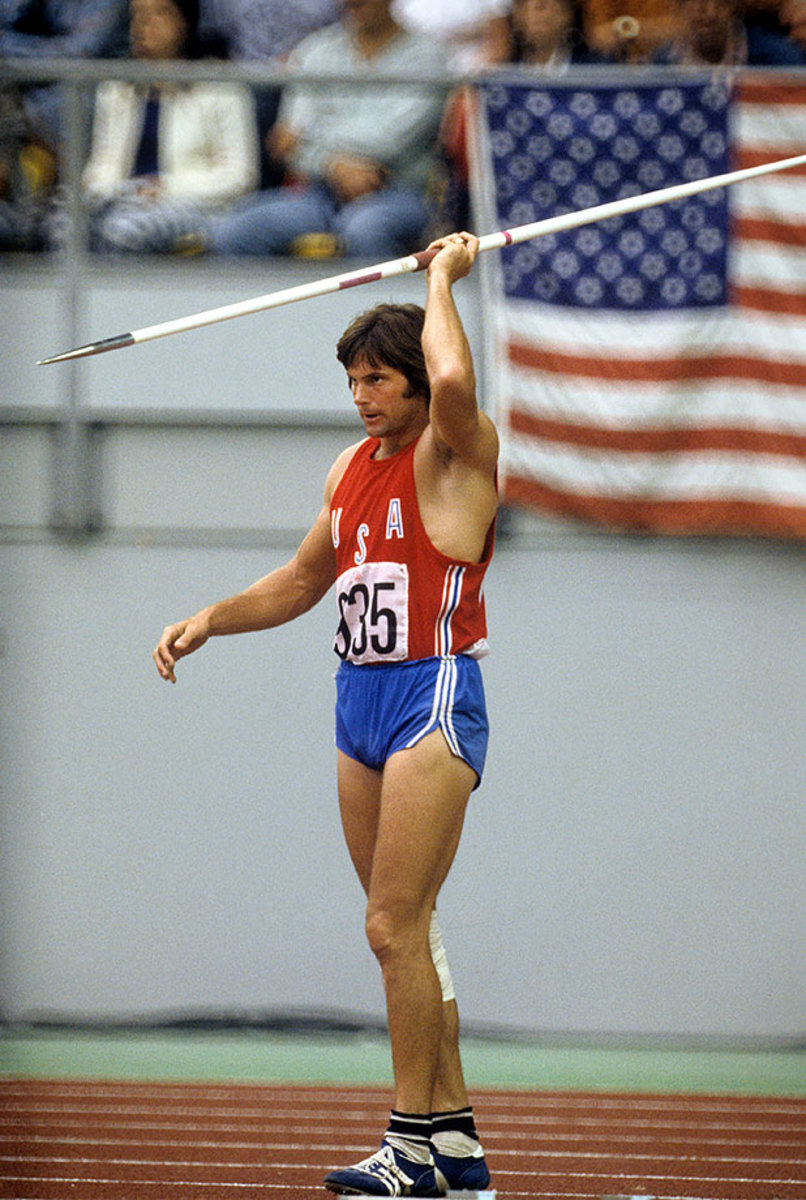
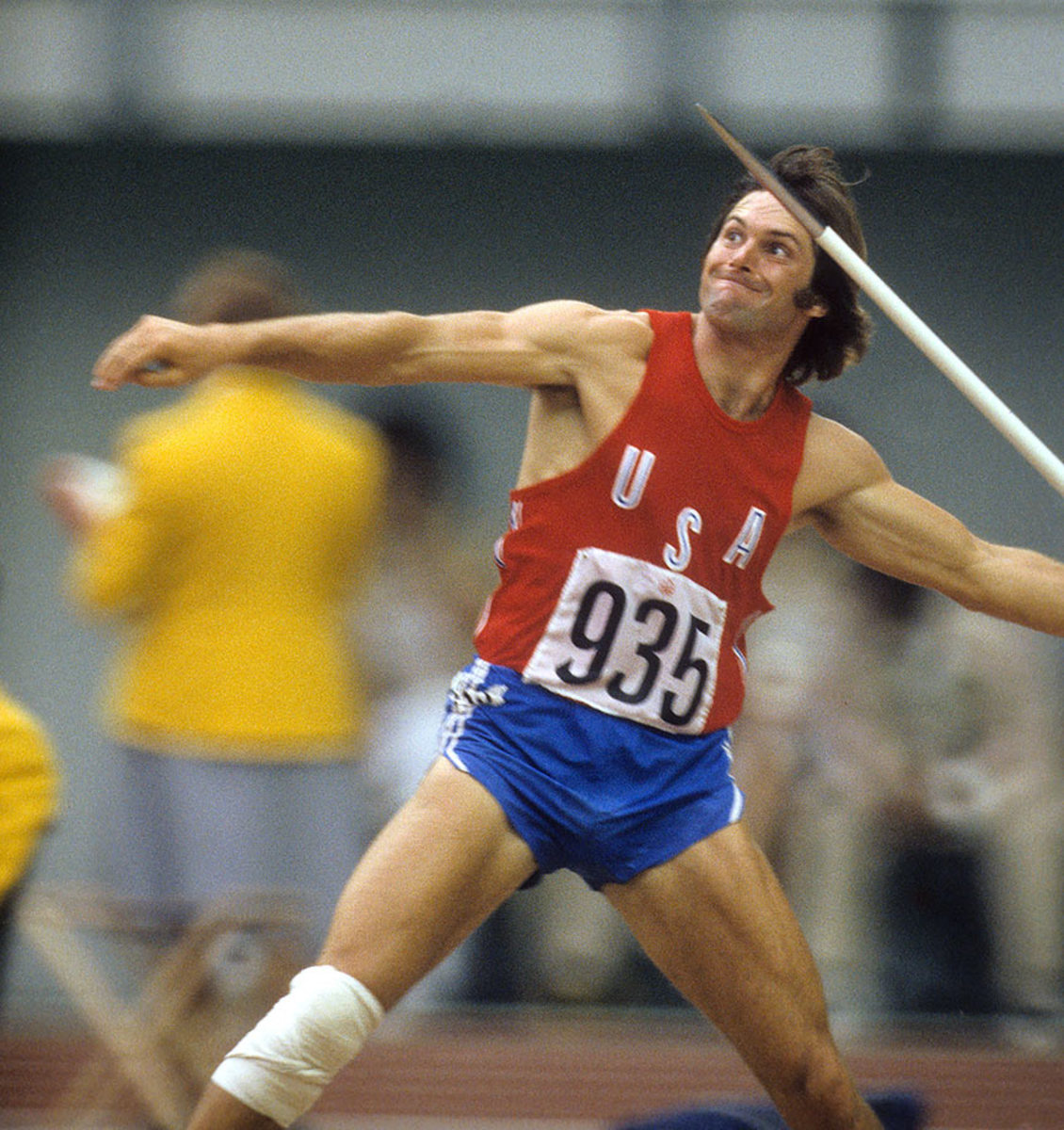
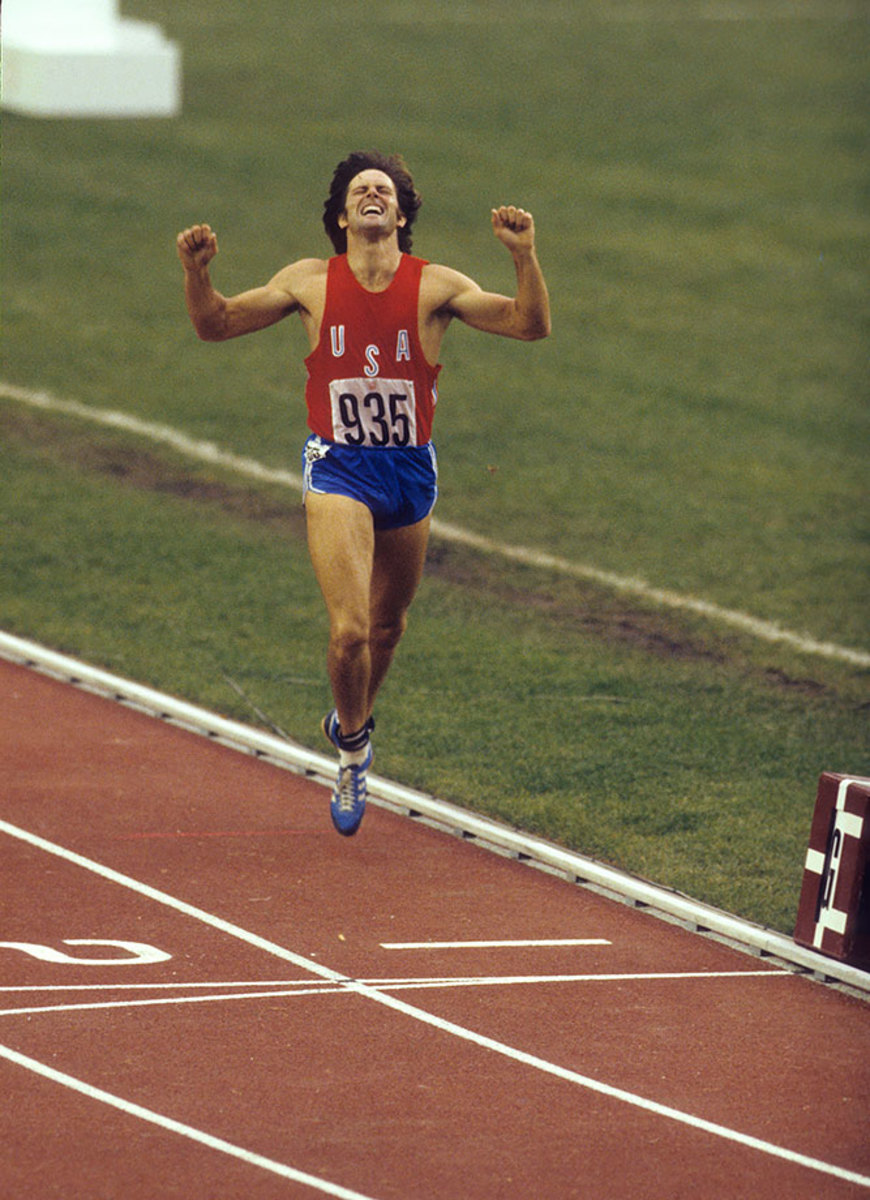
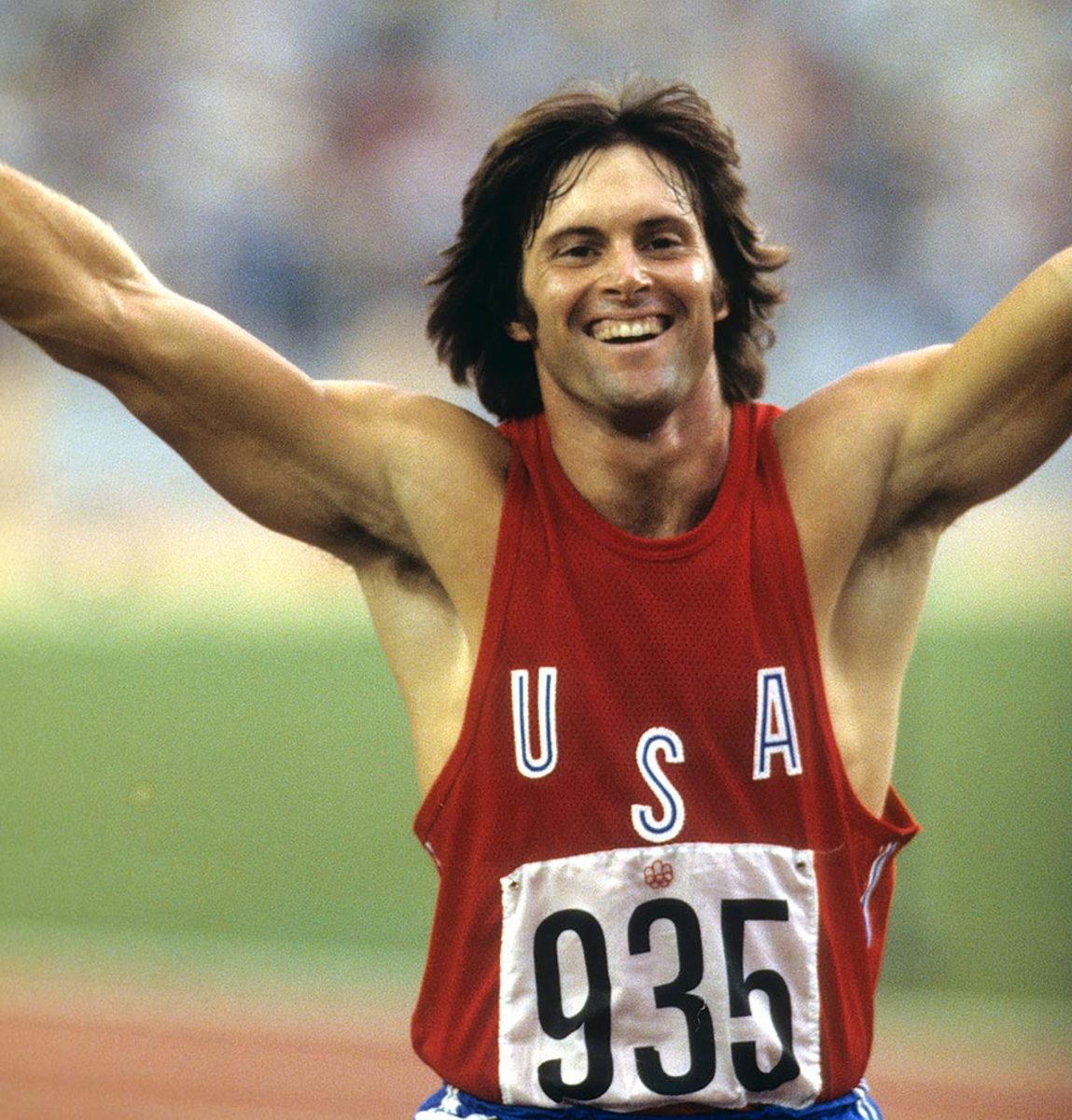
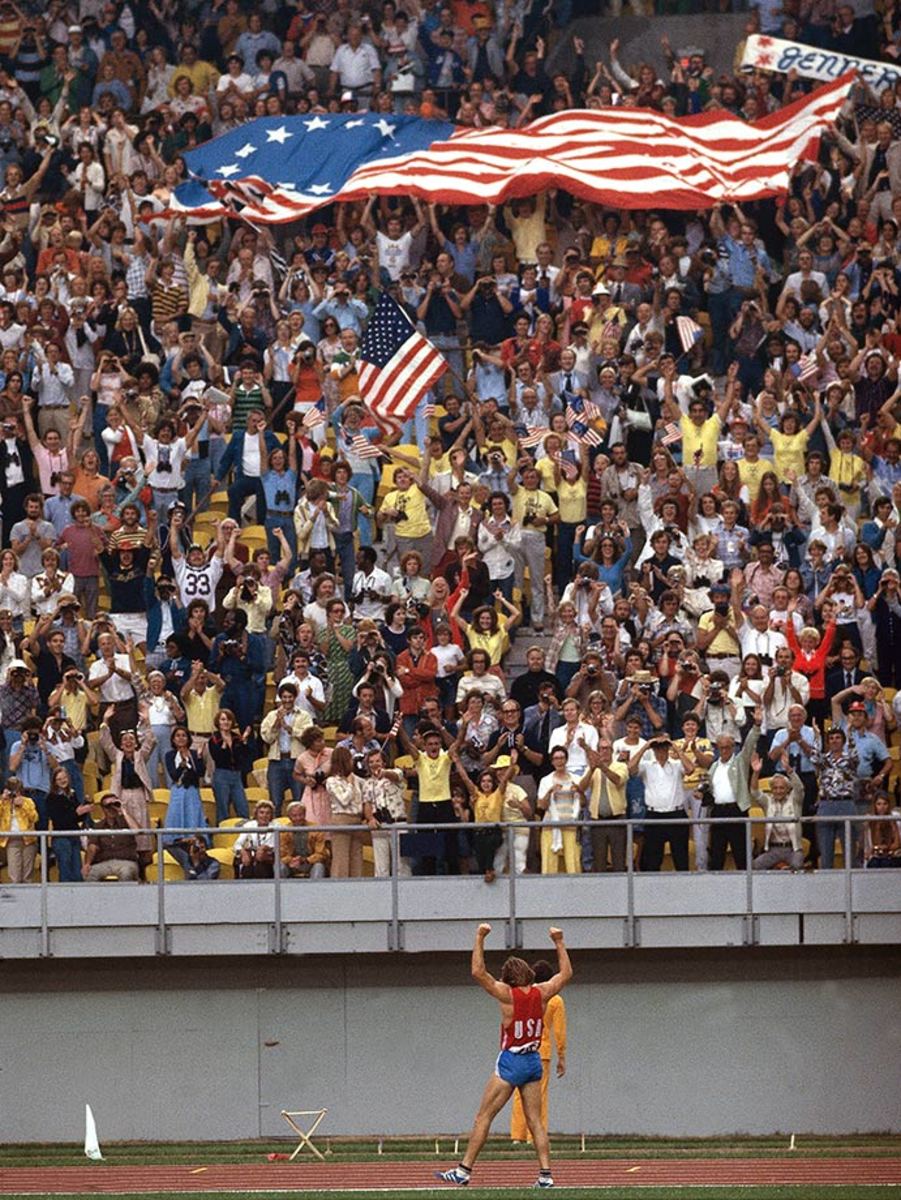
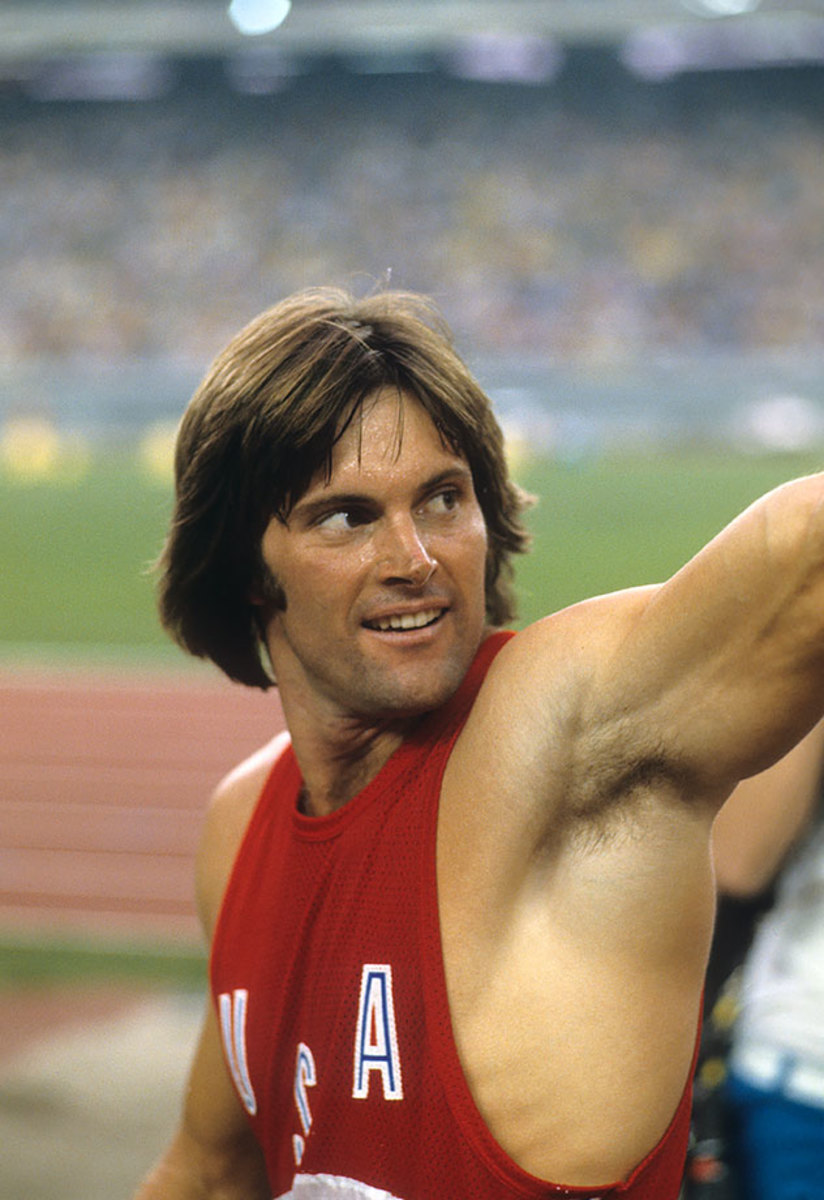
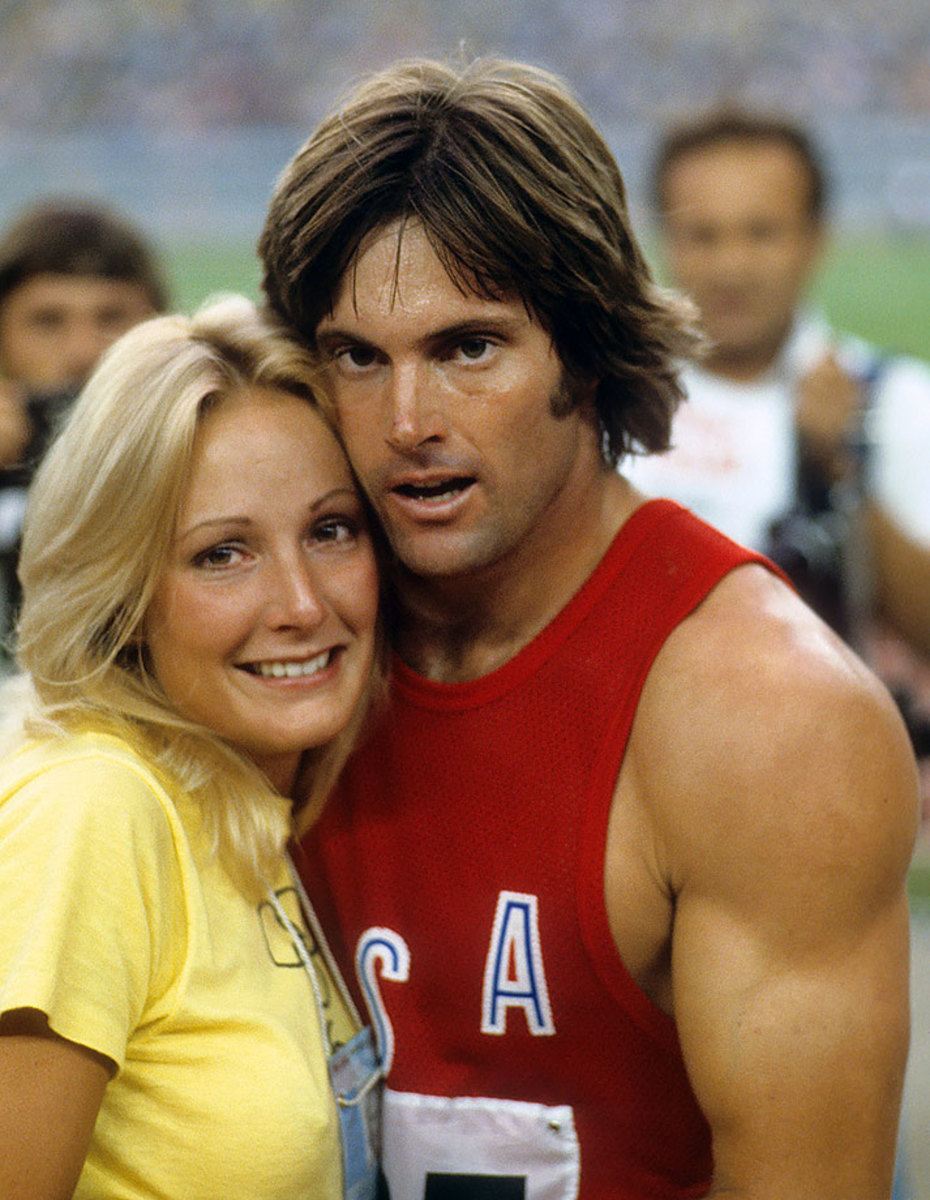
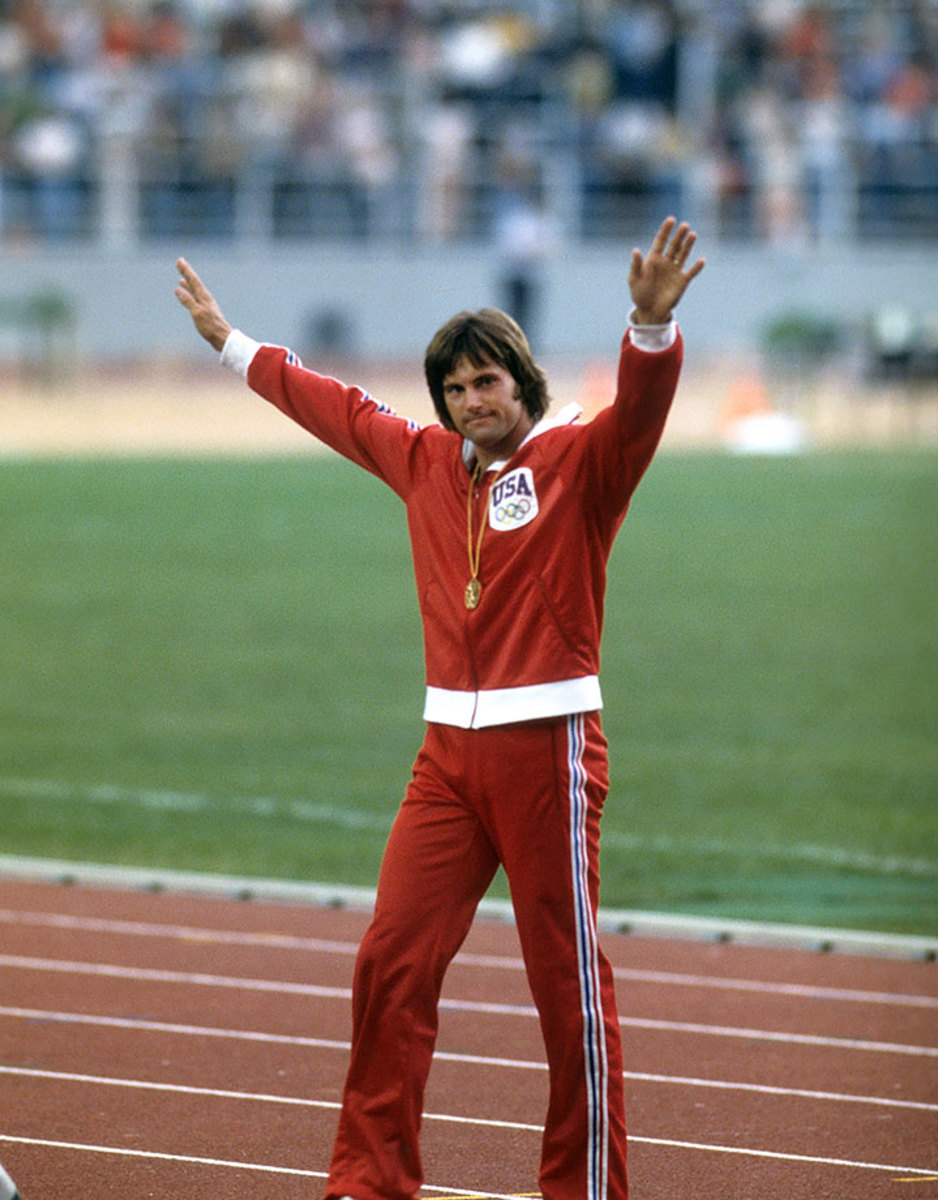
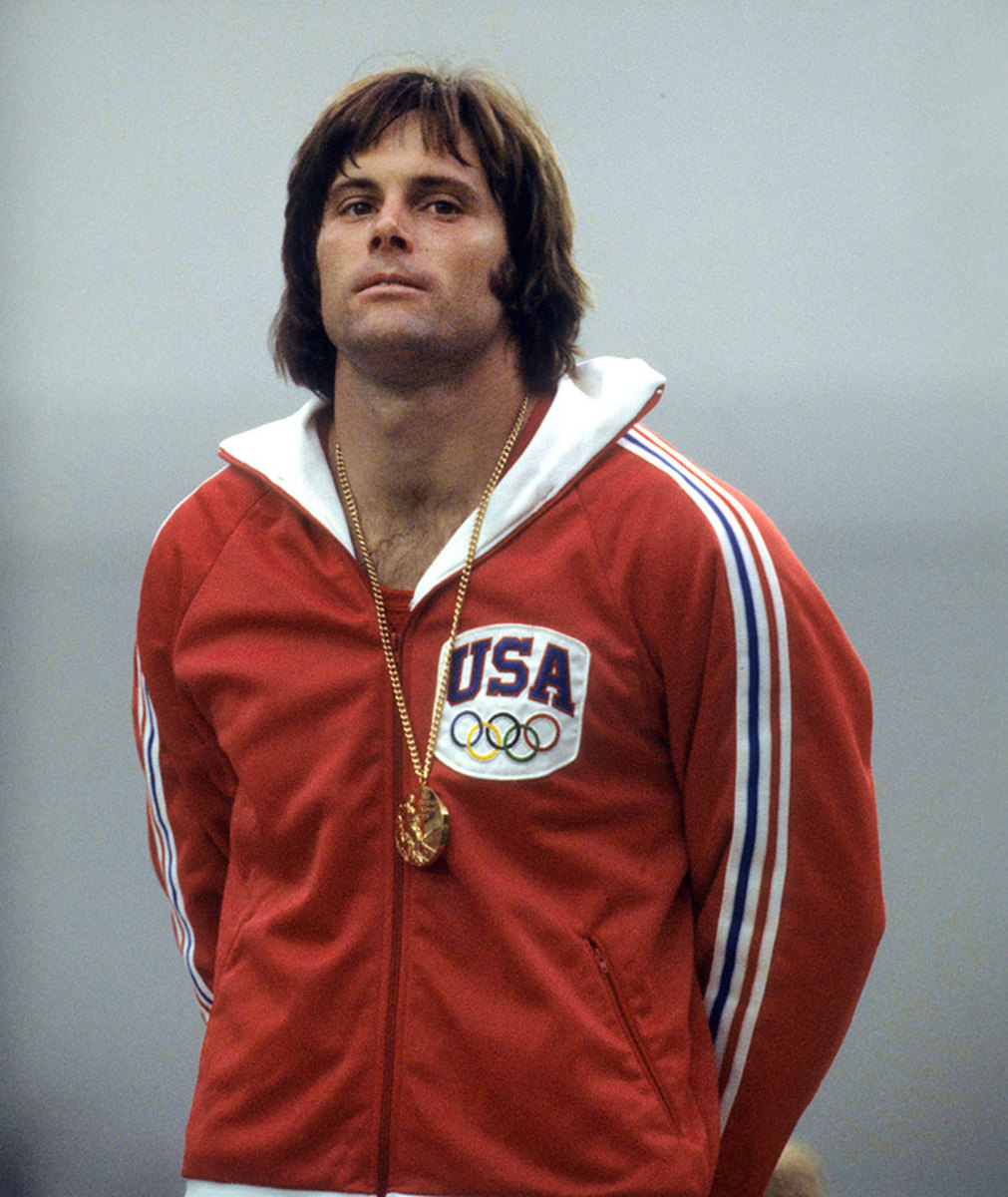
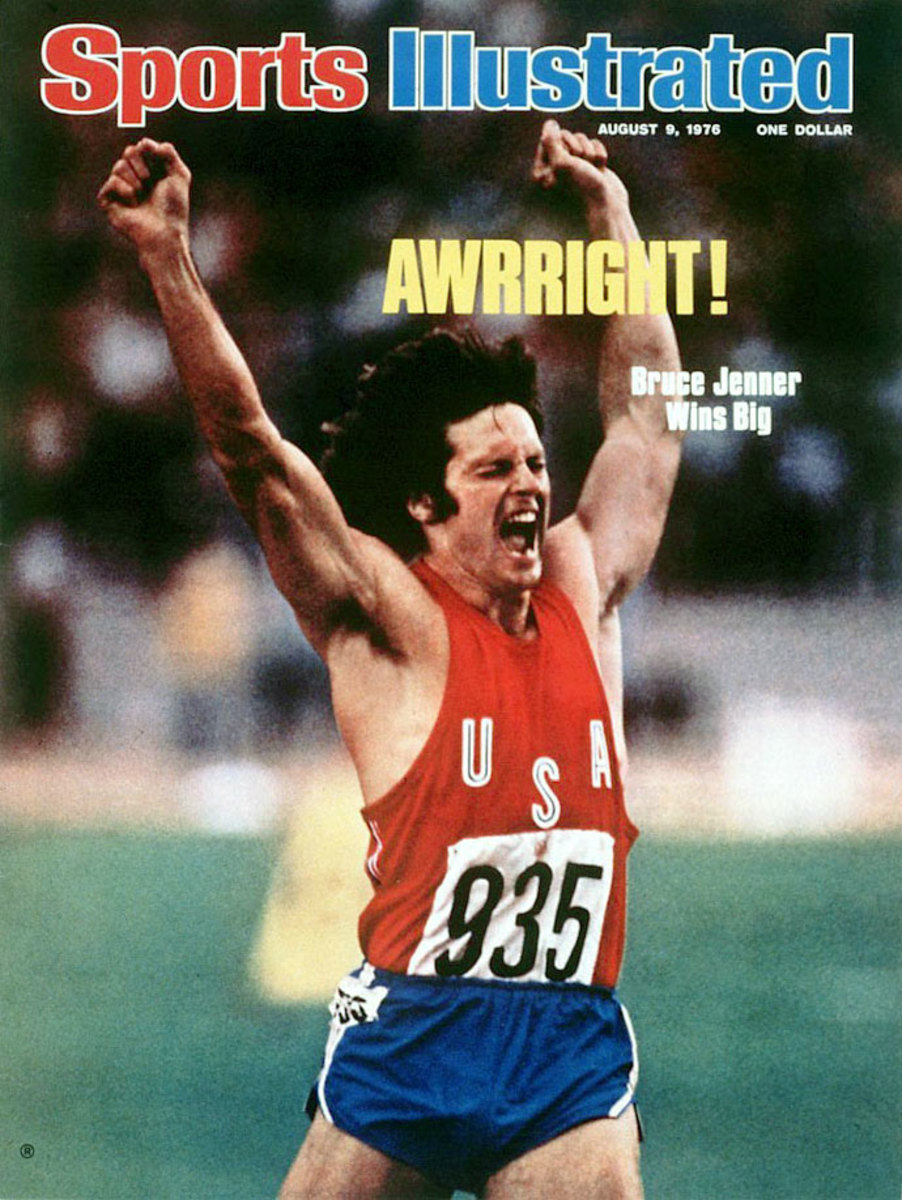
The decathlon in Montreal was almost anticlimactic. Three of Jenner’s best events—the pole vault, javelin and the 1,500—came at the end. He struggled briefly in the high jump, but Stones yelled to him from the stands, “Arms!” to get Jenner to engage his upper body more; he then cleared a personal best of 6' 8". When Jenner ran a PB of 47.51 in the 400 at the close of the first day—“Bruce always went all out in the 400 and died,” says Samara. “In the Olympics he didn’t die”—he trailed leader Guido Kratschmer of West Germany by 35 points and Avilov by 17. In essence the competition was over. After Jenner cleared his opening height in the pole vault, the eighth event, another decathlete approached him and said, “So Bruce, now you are a millionaire.”
Jenner could have jogged the 1,500 and won; he needed to run only 4:35 to break the world record. Zarnowski ran to the railing to tell him this, and Jenner said, “I know what I need.” He ran a personal best of 4:12.6, the equivalent of a 4:30 mile, his last 400 meters in 60 seconds flat. No previous Olympic champion had run the 1,500 faster than 4:22; none have since eclipsed 4:27.21. “I didn’t spend the last six years of my life training to run slow,” says Jenner now. He crossed the finish line, and a young man jumped from the stands and handed Jenner a small flag. (Caitlyn still has it, along with the uniform.) Chrystie climbed down from the stands in a yellow shirt that read, GO JENNER GO. They hugged. Jenner sensed himself holding not just his wife but also the moment. “This is going to be over,” Caitlyn recalls thinking, “and I’ve got a long life ahead.”
• From the Vault (1982): Bruce Jenner is living out our fantasies for us
At a party that night Jenner was introduced to an ABC executive, whom Jenner then introduced to Wallach. Now he had an agent. Looking back, Jenner says she had no real plans for the future. A few days before the decathlon, Jenner told SI’s Frank Deford, “I’m scared to say anything. Everybody is ready to be reminded of Spitz [who failed to cash in big on seven gold medals in 1972]. If I mention one thing about what I’m considering, everybody’ll say, ‘Hey, the kid’s just in it for the money.’ ” So Jenner was considering something—but not track and field. (He would never compete in another decathlon.) “No more mountains to climb,” says Caitlyn today. Also, no money on the table.
Jenner has told the story many times: Awakening in a Montreal hotel on the morning after winning the decathlon, he stood naked in front of a mirror, with the gold medal around his neck. Caitlyn tells it again today, and like so much of what was described through the years, it plays very differently in 2016: “I said out loud, ‘What the hell am I going to do now?’ ”
2016

On a cloudless winter day Caitlyn Jenner falls into the corner of the beige couch in the sunken living room of the $3.6 million home she bought in early 2015, after her third divorce. It is a flat, concrete house on the top of a bluff, a single floor with a garage underneath. There are no other houses nearby and few higher in Malibu; when Jenner’s transition was a tabloid-fueled rumor, paparazzi hunkered down in the distance and focused on the swimming pool with telephoto lenses. Through a window behind the couch, far beyond the brown hills and winding roadways, you can see the shimmering blue of the Pacific.
Jenner makes a track and field joke for me, the visiting sportswriter. “Glamour magazine Woman of the Year and Olympian decathlon gold medalist,” she says. “This has got to be the greatest double of all time, right? It will never be matched.” (A double is when an athlete wins two events in the same meet.) The former world’s greatest athlete is wearing skinny jeans and a loose ivory sweater and wedge sandals. She has diamond stud earrings, her nails are painted pink, and her hair falls loosely to her clavicle. When she moves, she moves with the subtle grace of an athlete. Male or female—doesn’t matter. Athletic grace is athletic grace.
There are two kinds of history: There is what happened and what we interpret through the prism of time. There has been no prism quite like Jenner’s. Forty years ago this July, Bruce Jenner stood in front of that mirror in that Montreal hotel, and this is what he really thought even then: “It disgusted me. I was big and thick and masculine. The rest of the world thought it was this Greek god kind of body. I hated it. But it’s what I was given, so I just tried to do the best I could with it.”
The story of the decathlon gold medalist is different now, shaped by Jenner’s transition. It is a more important story, and also far more complex. Millions of Americans have memories of Montreal, of the ABC telecast and of the SI cover, of all those episodes of Keeping Up with the Kardashians. That guy is this woman. It is an adjustment. “I get that,” says Jenner. “And I apologize for that part of it. It was my secret and my struggle. I understand that a lot of this is hard to grasp.” This was a half-century in the making. Jenner told Vanity Fair that he first began wearing his mother’s and sister’s clothing at age 10. Jenner began taking hormones in the mid-1980s, while living alone, twice divorced. “I was thinking that I would transition before age 40 [that would have been 1989],” says Jenner. “And I was really struggling with it. But the best way I can put it is, it just wasn’t time. It wasn’t time in my life, and it wasn’t time in society. The issue was totally misunderstood. The only person I had heard of was Renée Richards [the former Richard Raskind who transitioned in 1975 and played professional tennis for several years afterward].” More than two decades later—separated from Kardashian and living alone again in Malibu, his two youngest daughters in their late teens—Jenner made a decision in the fall of 2014 to finally transition. “Then it was time,” says Jenner. “I wasn’t going to continue to lie to myself.”
In one of our three interviews she leaned forward on the couch, held her right hand about four feet off the floor and said, “Little Caitlyn has been in there since I was this big. Sometimes she raised her cute little head more than others. I was female inside, but I wasn’t an effeminate male. So I could hide easily in the male world. My life was distraction after distraction after distraction. Being a macho male was a way for me to try to convince myself that the woman living inside of me really isn’t living inside me.” Here Jenner makes a sweeping motion over the whole of her female self. “Obviously,” she says, “it didn’t work.”
There is, however, an implication that Jenner’s decathlon training from 1970 to ’76 suppressed his gender issues. This is not true. “They were always there,” says Jenner. “You just don’t deal with them. I put my energy into beating the event.”
Samara remembers that around the time of his pole vault failure at the ’75 national championships, Jenner lacked his usual intensity. “It was very unusual for Bruce,” says Samara. “At the time he and Chrystie were getting into a lot of fights. We could hear them.” Jenner says that before and for several years after Montreal, Chrystie was the only person who knew of his gender issues. Is that what they were arguing about? “Chrystie and I were O.K. at that time,” says Jenner. “Even with her, I held back on how powerful this gender thing was. We fought because I was feeling the pressure to win the Games. I really had to win.”
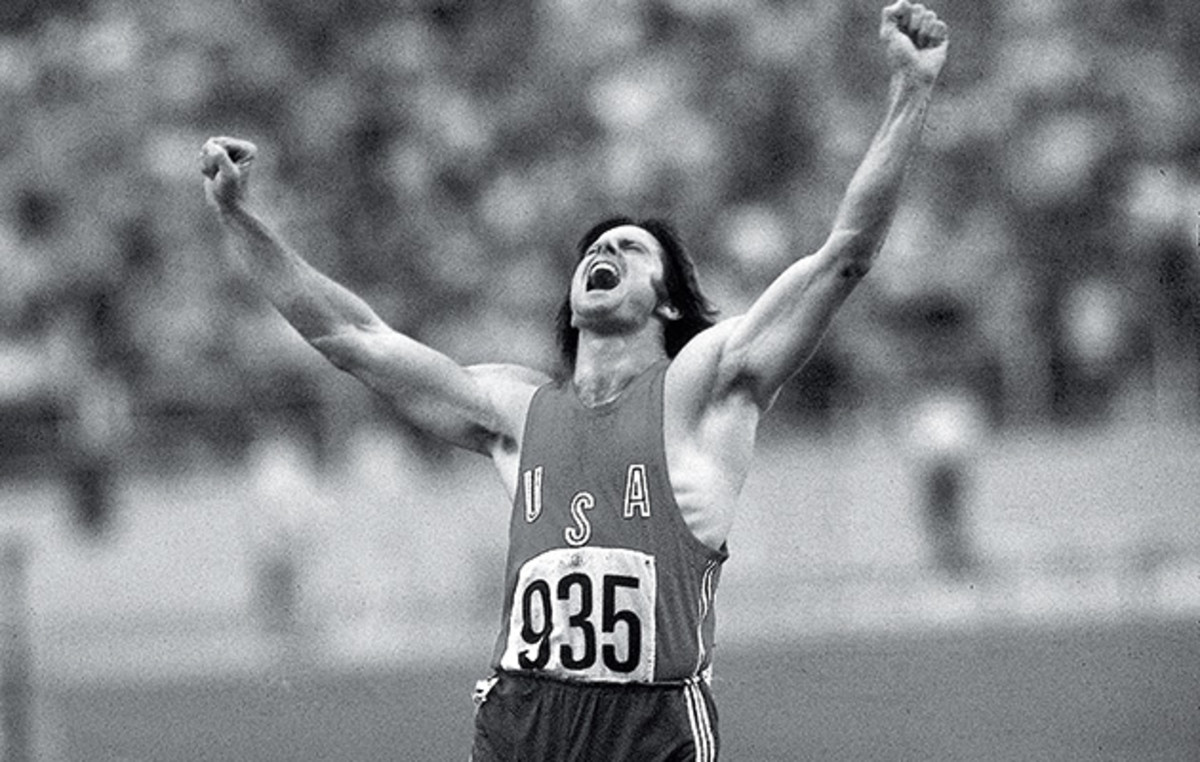
Al Michaels tells the story of working with Jenner, post‑Olympics, at a motorcycle race in Terre Haute, Ind., for a broadcast on ABC’s Wide World of Sports. Afterward, on a short flight, Michaels recalls that Jenner, then 27, asked Michaels if he had ever considered having plastic surgery. “I’m thinking, I’m 32, why would I do that?” says Michaels. “Bruce says, ‘If you do it when you’re young, nobody notices.’ ” Caitlyn laughs at hearing the story today. “I was always considering plastic surgery,” she says. “When you’re gender dysphoric, you’re constantly looking at yourself and seeing things that don’t look right.”
The day after the finish of the decathlon in 1976, Wilkins recalls standing on the balcony outside the housing complex that a group of U.S. Olympians shared in Montreal. Jenner was with him, and they looked out over a field where dozens of athletes from around the world were throwing Frisbees. The U.S. men’s track and field team had won only four individual gold medals, but one was by Wilkins and one by Jenner. Their work in San Jose had paid off. “I looked over at Bruce, and I said, ‘Well, what did you expect?’ ” says Wilkins. “He just nodded his head and said, ‘Exactly this.’ ” Wilkins heard satisfaction in those words.
It is common for transgender people to disavow their pretransition lives, which were often painful. Caitlyn disavows neither Bruce nor his accomplishments. “I loved Bruce,” she says. “I still love him today. I like what he did and the way he set an example for hard work and dedication. I’m proud of that part of my life. But this woman was living inside me, all my life, and it reached the point where I had to let her live and put Bruce inside. And I am happier, these last 12 months, than I’ve ever been in my life.”
Those who knew Bruce Jenner well are left to take this fresh information and recalibrate their memories. Jenner told none of her old track buddies in the spring of 2015 that she was planning to transition. Dan O’Brien spent many hours with Jenner in the 1990s and says, “Every time you saw Bruce, he would look a little different. This is all pretty shocking to me, but those different looks make some sense now.” All the former athletes found out by watching Diane Sawyer or by reading stories a day later.
Some reached out to Jenner. Marra texted her, and a few days later she called him. They talked for three hours. A week later she called again, and they talked for two more. “The way I remember it, she’d like to have an impact,” says Marra. “She referred to herself as Jenner, so maybe she was trying to make things comfortable for me.” Samara has reached out but has not heard back.
All of them support her. “It’s a little surprising,” says Feuerbach, “but it doesn’t change a thing about the way I feel about our friendship.” Wilkins says, “He must have been in such horrible angst for a lot of his life. I can’t even imagine it.”
Stones recalls his own struggles with advancing age. “People passed me, and that felt like torture,” says Stones. “Nobody ever passed Bruce. He finished it and walked away. But then he carried this burden around for so long. It must have been torture. And what Caitlyn is doing now? Awesome.”
Eaton met Jenner at the 2012 trials, in Eugene. “Bruce told me how the Olympics were different, with a different kind of pressure, but just keep doing what I know how to do,” says Eaton. “He’s one of those guys in the sport you respect. The transition, that took a lot of courage. I admire her for that. She seems happy now.”
Soloway, meanwhile, summons up a different image from Montreal, marinated over time, adjusted for recent events. “When she was Bruce, she was pretty,” she says. “A lot of female athletes at that time were very, very butch. Bruce was beautiful and graceful.”
Jenner’s announcement last spring made her the most well-known transgender person in America, and possibly in history. (She is certainly on a very short list that would include Christine Jorgensen, whose transition in the 1950s was a national story; Richards; and Orange Is the New Black actress Laverne Cox.) Given her Olympic history, her celebrity and the tabloid rumors, it’s unlikely she could have transitioned privately, but she chose to do so very publicly, she says, with a goal. “Maybe I could make a difference,” she says. “This issue doesn’t deserve to be in the gutter anymore.”
Jenner has been criticized for being insensitive to the difficult lives of many trans people, because her wealth and fame insulate her from many of their concerns. But she did transition in view of the entire world, and has remained there. “That takes an extraordinary amount of bravery,” says Olson-Kennedy.
Transgender society remains on the margins of acceptance. The estimate of 700,000 trans Americans is presumed to be low because many trans people are reluctant to come forward. A 2011 study by the National Center for Transgender Equality and the National Gay and Lesbian Task Force found that trans people are four times more likely than the general population to live in poverty. A stunning 41% of respondents reported attempting suicide. Thirteen trans people have been murdered in ’16, and at least 11 transgender teenagers took their own lives last year. The June 12 shootings at a gay nightclub in Orlando appear to have been an act of intolerance against the LGBTQ community; Jenner posted a tweet that day: “Shocked & heartbroken. Sending all my thoughts & prayers to my brothers & sisters in Orlando. Be safe the rest of this weekend friends #pride.”
It is a populace often in crisis, evolving, and not well understood by society. Jenner has tremendous power but little experience as a trans advocate, or even as a transgender person. Says Jenner, “I’m only a spokesperson for myself and my own story.” But her show includes several trans women with vastly more experience. In a sense Jenner does advocacy simply by playing herself. During February’s Fashion Week in New York City, Kris Kardashian touched off a small tabloid frenzy when she said that Caitlyn was the worst-dressed of their clan. Soloway found this remarkable. “People are talking about whether Kris or Caitlyn has the better dress, instead of, ‘Hey, Kris’s partner is transgender,’ ” she says. “So Caitlyn becomes just another Kardashian plot, instead of being transgender. That’s a totally positive thing.”
Last summer Jenner received the Arthur Ashe Courage Award at the ESPYs, a decision that NBC’s Bob Costas called a “crass exploitation play.” Barbara Walters named Jenner her “Most Fascinating Person” of 2015, and Glamour named her its Woman of the Year—half of Jenner’s “double.” However, when Jenner told Buzzfeed that “the hardest part about being a woman is figuring out what to wear,” actress Rose McGowan wrote a Facebook post in which she said, “Caitlyn Jenner, you do not understand what being a woman is about at all.” After a speech last November in Chicago, Jenner was confronted by several protesters who called her “an insult to trans people.” In an episode of I Am Cait that aired in mid-March, she said that Donald Trump “would be very good for women’s issues,” while also criticizing his “macho attitude.” In the same show she said that she would “never, ever, ever vote for Hillary [Clinton].” Transgender advocacy groups have traditionally viewed conservatives as adversaries, but Jenner also said, “Just because I’m a woman now doesn’t make me all of a sudden liberal.”
She is a massive target, yet chooses not to hide. Anything Jenner posts on Twitter, where she has more than 3.9 million followers, is met with subhuman bile rising from the deep well of digital anonymity, along with a solid measure of Yas Queens! “She’s trying,” says triathlete Mosier. “People have bestowed this position on her, and she’s trying to do her best.” A shrill minority suggests that Caitlyn’s gender change is a ploy to drum up interest in various Kardashian properties, cynicism so dark that it tests one’s faith in the human spirit.
Her old Olympic world struggles with gender definitions. Female sprinter Dutee Chand of India, who is hyperandrogenic (she has a naturally higher level of testosterone than international track and field customarily allows), challenged a ruling that she had to either take hormone-suppressing drugs or undergo surgery to limit testosterone production to be allowed to compete against women. Last July the Court of Arbitration for Sport ruled in Chand’s favor and held that testosterone level alone is not sufficient cause for denying women the opportunity to compete against women. (The ruling is provisional, track’s governing body has two years to provide further science.) Chand’s case has brought attention and controversy to hyperandrogenic middle distance runner Caster Semenya of South Africa, who is a favorite for Rio and is approaching record times run by Eastern European athletes in the steroid-soaked 1980s.
In January the IOC struck language from its bylaws requiring transgender athletes to have gender reassignment surgery before being allowed to compete. Each ruling moves athletics closer to a position where gender is a spectrum, rather than a one-or-the-other proposition. Jenner is acutely tuned to the information in this arena. During one interview she opened her laptop and pulled up several stories related to gender and sports and encouraged me to write about the topic. “When you see what’s happening in this country on the bathroom controversy, politicians just don’t understand or get it at all. When it comes to this subject, the Olympic movement is far ahead of the rest of the world. Good for them,” she says. (Jenner does not discuss whether she has had, or plans to have, reassignment surgery. “It’s nobody’s business whether I want to do that to my body,” she says).
Now she sits at the dining room table in her home. Over her left shoulder, the sun is falling toward the Pacific. The view is stunning. Jenner could tell Olympic stories all day; about going back to Montreal a decade ago and, for the first and only time, visiting the stadium. The track was gone and everything looked different. It was disorienting. There is a plaque outside with the names of the medalists, and that was nice to see.
Not long ago she hosted a group of her transgender friends for dinner. They all wanted to see her medal, and Jenner broke it out and everybody took pictures with it and with Caitlyn—show-and-tell all over again. In the late afternoon Jenner fell silent as two men stood nearby and talked about the NFL, the Broncos, and the Rams coming to Los Angeles. Finally she shook her head theatrically and then raised her chin as if insulted. “Oh, you guys and your football talk,” said the decathlon gold medalist, and then Caitlyn Jenner laughed. At history. At convention. At herself. A single word—transition—never seemed more appropriate.
